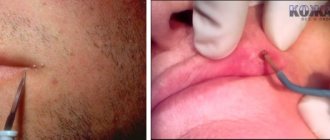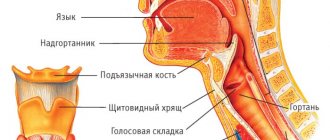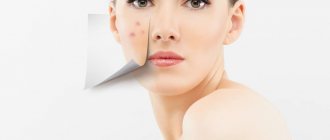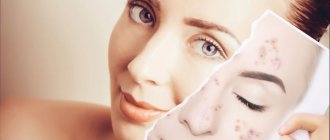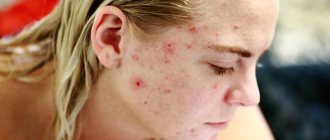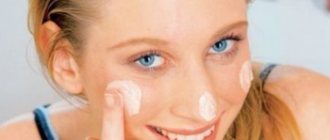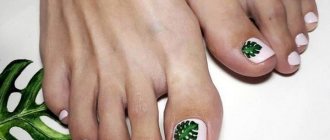Acne classification
Pimple is a generalized concept that is used widely among people. Experts use a classification of acne, which divides them according to shape, causes, age and severity.
Determining the type of acne is necessary to select effective treatment.
Depending on the presence of the inflammatory component, acne can be inflammatory or non-inflammatory.
A non-inflammatory pimple is a comedon, which is often the original form of inflammatory acne and is a clogged skin pore with fat containing particles of dust, epithelium, cosmetics, etc.
In turn, comedones are divided into closed and open.
In a closed comedon, the sebaceous plug is located in the deep layers of the skin and has no outlet, so it looks like a white tubercle. An open comedon is localized in the proximal part of the skin pore, so its contents can be evacuated independently.
We will consider the mechanism of comedones formation below.
Inflammatory acne includes the following elements:
- papule is a small red bump that rises above the surface of the skin. Papules are mainly caused by infected acne. Also, this type of acne is often a manifestation of allergies and goes away without a trace, but it can also be an intermediate form of other inflammatory acne. After the papules have regressed, post-acne may remain in the form of a speck;
- pustules are essentially an abscess that rises above the skin, has purulent contents in the center and signs of inflammation (pain, itching, redness). Pustules always leave behind spots, scars or pits;
- nodes are papules that are located in the deep layers of the skin and are characterized by severe pain and a dark red or blue tint to the skin above them. The nodes reach quite large sizes - 10-30 mm and never pass without a trace, leaving scars, atrophy and pigmentation;
- cysts are formed from several suppurating nodes, which are connected to each other by fistulas. This type of acne often leaves behind skin changes in the form of keloid scars.
Depending on the age at which acne appears, they are divided into the following types:
- baby or infant pimples that have the appearance of millet grains, which is why they are called milia. The cause of milia is the effect of mother's hormones on the baby's body. Infant acne is not considered a pathology and goes away on its own and without a trace;
- teenage acne is a consequence of an excess of sex hormones in the body during puberty;
- adult acne almost always reflects the condition of internal organs and can indicate some kind of disease.
Pimples in the décolleté area
A scattering of acne on the décolleté area is not uncommon. Most often, the reason is elementary - uncleanliness. But if your chest is covered with acne that itches and hurts, then you should consult a specialist for a diagnosis.
Reasons for appearance
Common factors that provoke the appearance of rashes are:
- seborrhea;
- allergic reaction;
- stress;
- hormonal imbalances;
- illiterate care of the dermis.
What can it be a symptom of and how to recognize it
Seborrhea is understood as the active production of glandular secretions. Pimples appear on the chest more often in men who actively play sports and take steroids.
https://youtube.com/watch?v=8kvatWhZ82U
With keratosis, keratinized cells appear that accumulate around the bulbs. Small bumps appear.
With allergies, small red pimples appear on the chest, which itch and itch. As soon as contact with the allergen stops, they disappear.
In case of frequent stress, rashes usually appear not only on the chest, but also along the spine. The dermis becomes covered with red pimples and there is no discomfort.
If there are problems with hormonal levels, a rash with pus and progressive inflammation.
What tests should I take?
To identify the cause of acne on the chest, you will need to undergo tests:
- on a hormonal panel;
- to allergens;
- general blood test and biochemistry.
How to get rid of it quickly
You can use:
- antibiotics for oral administration;
- disinfectants;
- alcohol infusions and solutions;
- antiphlogistic agents;
- anti-allergy remedies;
- hormonal ointments;
- tar soap;
- herbal decoctions;
- clay masks.
Prices for Propeller Immuno Salicylic suspension “Boltushka” for acne
A selection of acne medications
Acne on the back: how and why do they appear?
Basically, the pathogenesis of acne on the back consists of increased production of sebum and slower clearance of skin pores from epithelial scales. As a result, plugs are formed in the pores of the skin, consisting of sebum, dust, epithelial cells, cosmetics and other polluting particles.
This is how comedones appear, or, as people say, blackheads. The black color of comedones is due to the fact that fat oxidizes under the influence of oxygen.
Clogged pores prevent the skin from breathing normally and disrupt sweating, and the presence of opportunistic flora and contributing factors leads to comedones becoming inflamed, turning into papule, pustule or other types of acne. But the listed elements of the rash can also occur primarily, and not through inflammation of comedones.
Now let's look at why acne appears on the back.
Acne can be caused by the following factors:
- disturbance of heat exchange, which occurs due to poor-quality clothing, as a result of which comedones appear on the back, and over time, papules and pustules;
- incorrect or irrational peeling of the back skin leads to damage to existing comedones, papules or pustules, resulting in acne appearing on healthy areas of the back skin;
- low-quality skin care products can clog pores, interfere with the release of sebum, change the pH of the skin, and this, in turn, will cause acne;
- unhealthy and unbalanced diet: consumption of large amounts of animal fats and proteins, as well as sweets, fast food, spices, etc.;
- bad habits: alcohol abuse, smoking, etc.;
- failure to comply with personal hygiene rules contributes to contamination of skin pores, which can become inflamed and turn into acne;
- hypersensitization of the body upon contact with an allergen or, simply put, allergic dermatitis. Acne of an allergic nature is characterized by small red papules, which can sometimes become infected and turn into pustules. Allergens in this case can be food, cosmetics, dust, pollen, animal hair, synthetic clothing, etc.;
- diseases of internal organs, which can affect the condition of the skin. Diseases of the liver, kidneys, pancreas, intestines and female genital organs are most often the causes of acne on the back;
- infectious diseases: chicken pox, rubella, measles and others;
- hormonal imbalance in the body. For example, during puberty in adolescents, hormonal changes in the body begin, which contributes to the appearance of acne. Rashes are also very often observed on the face, back, shoulders and other areas of the skin in women during menstruation. If we talk about men, their desire to gain muscle mass with the help of anabolic hormones and proteins often results in red pimples on the back;
- genetic predisposition to acne;
- disorders in the psycho-emotional sphere, such as prolonged depression, chronic stress, systematic mental overstrain, etc.;
- Vitamin deficiency, especially deficiency of pantothenic acid, contributes to acne on the back and others.
External causes of acne on the back
In this case, rashes on the back and shoulders are an inflammatory reaction of the skin to an unfavorable environment. The most common causes of acne are:
- Insufficient hygiene . The skin in the area of the shoulder blades has a large number of sebaceous glands. And while some people produce little fat, others produce much more. If a person falls into the second category, it is important to be more careful about back hygiene. After all, sebum is an excellent breeding ground for the proliferation of various bacteria that cause acne.
- Synthetic clothing . Synthetics often play the role of a kind of thermos, which is why a person sweats more actively. At the same time, sweat remains on the skin and, like fat, promotes the proliferation of microbes.
- Clothes that are too tight . Sweaters and T-shirts that stick to your skin can rub dirt and sweat into your pores.
- Loose hair . The ends of the hair irritate the skin. In addition, the hair “shares” its own dirt and oil with the skin on the back.
- Using the wrong cream or lotion. For example, an excessively greasy sunscreen. It will protect your back well from the sun's rays, but it will clog your pores, increasing the risk of inflammation.
The appearance of skin rashes can be caused by many other factors. Among them is the habit of wearing a backpack or constantly driving a car (the back constantly rests on the seat, which does not allow the skin to “breathe” and irritates it).
What is the danger of acne?
The danger of acne is that it not only leaves acne behind, but also increases the risk of infection entering the blood.
Post-acne is skin changes that appear after acne regression and are pigment spots, hypertrophic and atrophic scars. The worst post-acne scar is considered to be a keloid scar, which can only be removed surgically.
Acne spots on the back can be red, brown, blue, burgundy or brown.
A hypertrophic scar is formed due to increased collagen formation and has the appearance of a formation protruding above the surface of the skin, which can have different shapes and sizes. An atrophic scar appears as a local retraction of the skin, that is, a pit.
Acne spots on the back, like on any other part of the body, go away in 3-4 weeks, but scars are difficult or completely impossible to get rid of. It happens that having cured acne, we get rid of their scars much longer.
The most dangerous complication of acne is sepsis - the penetration of pathogenic microbes into the bloodstream. The risk of getting blood poisoning is increased in those people who constantly squeeze pimples, because this is absolutely forbidden to do. It is better to entrust this procedure to a cosmetologist.
How do blackheads on the chest form?
Morphologically, blackheads on the skin can be divided into two large categories:
- associated with blockage of hair follicles;
- formed as a result of local excess melanin synthesis.
Normally, sebum is secreted from the corresponding gland into the hair funnel, and from there it comes out.
With its excessive formation and increase in viscosity, fat accumulates in the epidermis around the hair, and small hard papules appear on the skin. This is how two types of comedones arise:
- Closed. They have the appearance of whitish papules that are prone to infection with subsequent formation of pimples.
- Open. They look like widened mouths of the hair funnel with a large amount of fat and dead epidermal cells. Due to excess melanin in the secretion of the glands, such comedones look like dense blackheads.
Any formations on the chest in the form of black dots must be monitored, because they can become infected and inflamed, and age spots can also degenerate into neoplasms.
Question to the expert
After 40 years, a rash in the form of 10-15 black dots appeared under my breasts. They do not protrude above the skin, but they do not disappear either. I tried to remove them and cleanse the skin with scrubs and creams, but to no avail. The mammary gland does not hurt. Is it possible to somehow squeeze out such black dots on the chest?
It is possible that you have pigment spots due to hormonal changes. If their number is not growing and they do not bother you, then you should not try to remove them. If there are suspicious changes in blackheads in the future, contact your oncologist.
How to get rid of acne marks on your back?
Post-acne treatment can be carried out in special clinics and beauty salons. But such a service is quite expensive, so most patients try to cope with acne marks on their own. Undoubtedly, this can be done at home, but you should definitely consult a dermatologist or cosmetologist.
Post-acne treatment is carried out using the following cosmetic procedures:
- ultrasonic, mechanical, combined and other types of back skin cleansing;
- peelings;
- laser therapy;
- mesotherapy;
- quartzing;
- photodynamic therapy;
- Darsonvalization and others.
In the fight against acne scars, a number of drugs are used, namely:
- Contratubeks;
- Sledocite;
- Dermatix;
- Gel and spray Kelo-kot;
- Kelofibrase and others.
The listed drugs resolve scar tissue, normalize the production of collagen fibers, smooth the skin, normalize microcirculation in the post-acne area and eliminate inflammation.
At home, to treat red spots on the back after acne, you can use the following methods:
- clay and rosemary oil : 1 tablespoon of green powder is diluted with 100 ml of water and 3-4 drops of rosemary oil are added. The mask is applied to the skin of the back every day for 20 minutes, after which it is washed off with warm water;
- bodyaga : 1 tablespoon of bodyaga powder diluted with 20 ml of a 3% solution of hydrogen peroxide and applied pointwise with a cotton swab to the spots 2-3 times a day until the skin is restored;
- apple cider vinegar : 100 grams of apple cider vinegar diluted with 300 ml of water. Wipe the skin of the back with the prepared solution every day 3-4 times a day;
- tea tree oil : mix 1 tablespoon of ether and lemon juice, then lubricate acne spots 2-3 times a day;
- parsley decoction : the specified decoction is poured into ice molds and frozen. Use ice cubes to wipe away acne marks several times a day.
Masks for cleansing pores at home
Cleansing mask with oatmeal:
- take 1 spoon of oatmeal;
- moisten them with water or milk and apply to the skin;
- The mask clears blockages on the nose and saturates it with essential microelements.
Recipe with dairy products:
- Chop the boiled egg shell;
- mix with a tablespoon of cottage cheese;
- put on your face and keep for 15 minutes, then rinse. This method is perfect for people with dry skin.
Recipe with gelatin:
- Dilute its powder with an equal amount of milk;
- heat in a water bath until the gelatin is completely dissolved and wait until it cools;
- Apply the mask to your face and wait until it dries;
- After this, carefully remove the dried film and wipe your face with cream.
Cleansing masks can be prepared with olive oil:
- Grate half a fresh cucumber and squeeze out the juice;
- Mix the resulting pulp with a spoon of olive oil and apply to your face for 20 minutes, then rinse.
Recipe with cabbage:
- mash the sauerkraut and apply to the face;
- its acid dissolves fat and whitens the skin.
Acne on the back in men and women: how to get rid of it?
The main thing in treating acne in both men and women is to establish the cause of the rash. To do this, during the diagnostic process, patients should be examined by an endocrinologist, a gastroenterologist, and others, and men must be referred for a consultation with a urologist if there is a suspicion that acne is caused by a hormonal imbalance.
Treatment of acne in men and women is carried out according to the principles described above.
You can get rid of acne on your back effectively and without harm to your health only under the guidance of a specialist. It is strictly forbidden to squeeze pimples, as this threatens to spread the process to healthy areas of the skin and blood poisoning.
Back acne is a delicate problem that affects many people. The fact is that it is this area that is most susceptible to acne formation - the sebaceous glands work most actively here, and the pores are susceptible to contamination. Follow our tips and let your skin be perfectly smooth!
Black spots on the chest - what to do?
If black comedones appear on the chest, there is no need to worry, because this cosmetic problem can usually be solved without drug treatment. If rashes occur all over the body, and not just on the chest, then this is a reason to consult an endocrinologist and dermatologist.
If there are internal causes of black spots on the chest, you cannot do without medical advice, because they will appear again and again until the disease that caused them is eliminated. If you have a few dark spots that don’t bother you, you can eliminate them yourself with the help of hygiene and cosmetic products.
If black spots appear on the breasts of pregnant women, it is better to consult a mammologist. After all, the skin of a growing female breast in this period is thinned, permeable and sensitive to external influences. Cosmetic creams, ointments and scrubs may not help against black comedones, but they can easily harm the susceptible mammary gland.
If the occurrence of comedones is of an allergic nature, their elimination boils down to stopping skin contact with the allergen. You can take antihistamines for several days to speed up the restoration of the skin to its normal state.
If black spots on the chest often appear among relatives, then it is quite difficult to influence their occurrence in a girl. It is almost impossible to combat the formation of comedones, which are caused by heredity. In such cases, all that remains is to prevent infection and regularly clean the skin.
Question to the expert
During my seventh month, black spots appeared on my chest during pregnancy. They cover the entire right breast above the areola. For some reason there are no rashes on my nipples. I squeezed out one of these - a thick white substance came out, but not pus. How can I treat my problem at home?
You most likely have open comedones. It is necessary to see a mammologist to assess the extent of the rash, its condition and prescribe treatment. During pregnancy, hygiene procedures are mainly indicated, because medical and salon methods can have a negative impact on the breasts.
How to get rid of acne on your back
Start simple
The causes of acne on the back can be external (for example, improper skin care) or internal (hormonal imbalance). To get rid of these nasty rashes, start with simple rules of hygiene and body skin care.
Wash your head correctly
Sometimes acne on a woman's back occurs because you wash your hair in the shower. How does all the dirty (sorry, but it really is dirty) water drain? That's right, on the back. And the conditioner clogs the pores even more.
Try washing your hair while leaning over the bathtub - by the way, it’s just convenient and for those with long hair, your hair will be less tangled. And watch for a couple of weeks - it is possible that the acne on your back will take offense and leave you forever.
Depilation at home: main rules and tips
Avoid greasy body lotions
Alas, even the highest quality body lotion can have comedogenic properties if it is too oily or simply does not suit your skin type. Try not to apply the cream to your shoulders and back for a while - there is a chance that it is the cause of the rashes, even if all other parts of your body do not react to the product.
Don't three pimples with a washcloth
A big mistake many girls make: rashes appear - you need to thoroughly rub your back with a washcloth! You get the opposite effect - you injure the skin where there is acne, and spread this crap all over your back, aggravating the inflammation. If there is such a problem, then you should avoid using a hard washcloth in this part of the body altogether.
Use salicylic acid
Lotions with salicylic acid are often recommended by dermatologists to combat facial acne. In fact, this product may turn out to be too “thermonuclear” for delicate facial skin, but if you use it on the back, it’s just right. Wipe problem areas of the skin with this lotion to dry out pimples.
Make masks from clay
Another, more gentle, but no less effective method is blue clay masks. Apply them to the back and shoulders 1-2 times a week. This mask helps to deeply cleanse pores and dry out breakouts. Only after these procedures proceed to the scrub!
Scrub
We have already said that a washcloth is not suitable for getting rid of acne on your back, but you can safely use a scrub after you have dried out your acne with masks or salicylic acid. Attention! Fresh pimples cannot be scrubbed - you risk bruising the skin, spreading acne all over your back, and even getting small scars.
So, remember the correct algorithm: first you need to wait until the acne dries, and only then use a body scrub to cleanse the skin.
If all else fails
If ordinary cosmetic procedures at home do not produce results, then most likely the cause of back acne is internal, which means you need to see a doctor. We talked about this topic with a cosmetologist and found out all the details of how to treat acne on the back.
The causes of inflammatory/non-inflammatory elements on the skin of the back can be both external and internal factors.
External factors include:
- clothes made from low-quality synthetic fabrics or tight-fitting clothes/use of other people's things (bed linen, bath sponge);
- the influence of unfavorable environmental factors - prolonged exposure to sunlight on the skin (in this case, the local immunity of the skin decreases).
In addition, humidity or, conversely, dry air can also negatively affect the condition of the skin;
- improper care - lack of proper hygiene (rare or, on the contrary, too frequent bathing).
Internal factors include:
— excessive secretion of sebum (a product of the sebaceous glands), changes in composition or blockage of pores;
- hormonal imbalance or imbalance (puberty, puberty);
- metabolic disease;
— disruption of the gastrointestinal tract;
How to tighten pores on your back
In general, the most effective way to combat both pore pollution and their “openness” is to regularly visit a bathhouse or sauna. Yes, you can also steam at home. At least sometimes. In a regular shower or bath. But what if you need to narrow your pores as soon as possible? To do this, we will offer the following several recipes.
- Blue clay. An excellent method to forget about enlarged pores on the back is to make masks with clay. It is very simple: a little blue clay in powder form is diluted in warm water, and then the problem area, previously steamed, is covered with the mixture. When it dries, you can wash it off.
- Honey with sea salt. It’s also an excellent mask if the honey is liquid (you can use melted honey, but it’s not as effective). The prepared mixture is applied to the area where enlarged pores are particularly bothersome and washed off after drying.
- Egg white with lemon juice. For greater efficiency, it is better to take a couple of quail eggs. They are mixed with the juice of half a citrus fruit, and then everything is as in previous cases.
- Herbal decoctions. There are many recipes, but the most effective, perhaps, is a mixture of calendula, chamomile and sage. The finished decoction not only narrows the pores, but also inhibits the functioning of the sebaceous glands. Accordingly, you can use this recipe for prevention.
- Salicylic acid. It helps to narrow and at the same time disinfect pores. Works well especially in combination with tea tree oil. 5 drops are enough because the component is very active.
